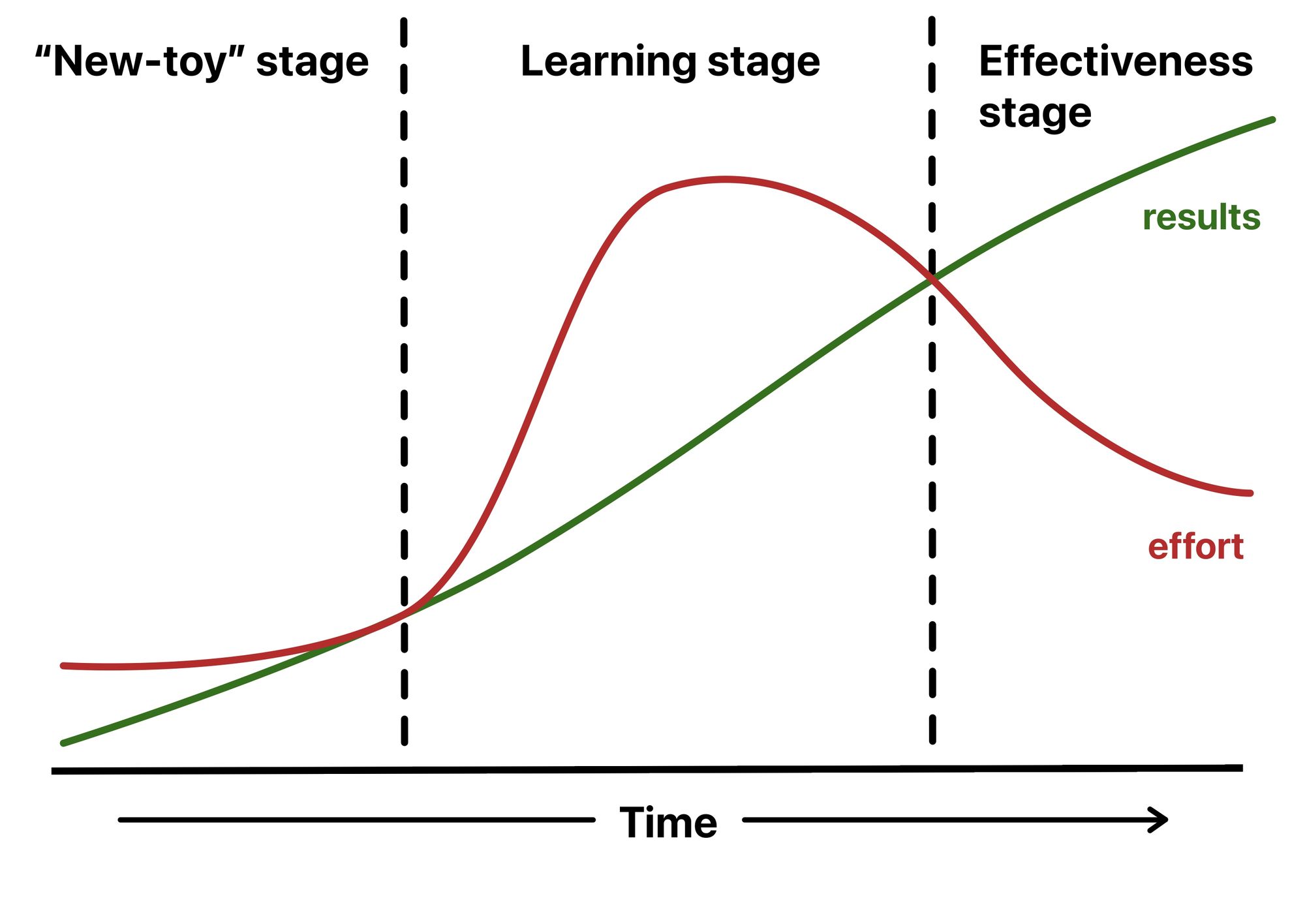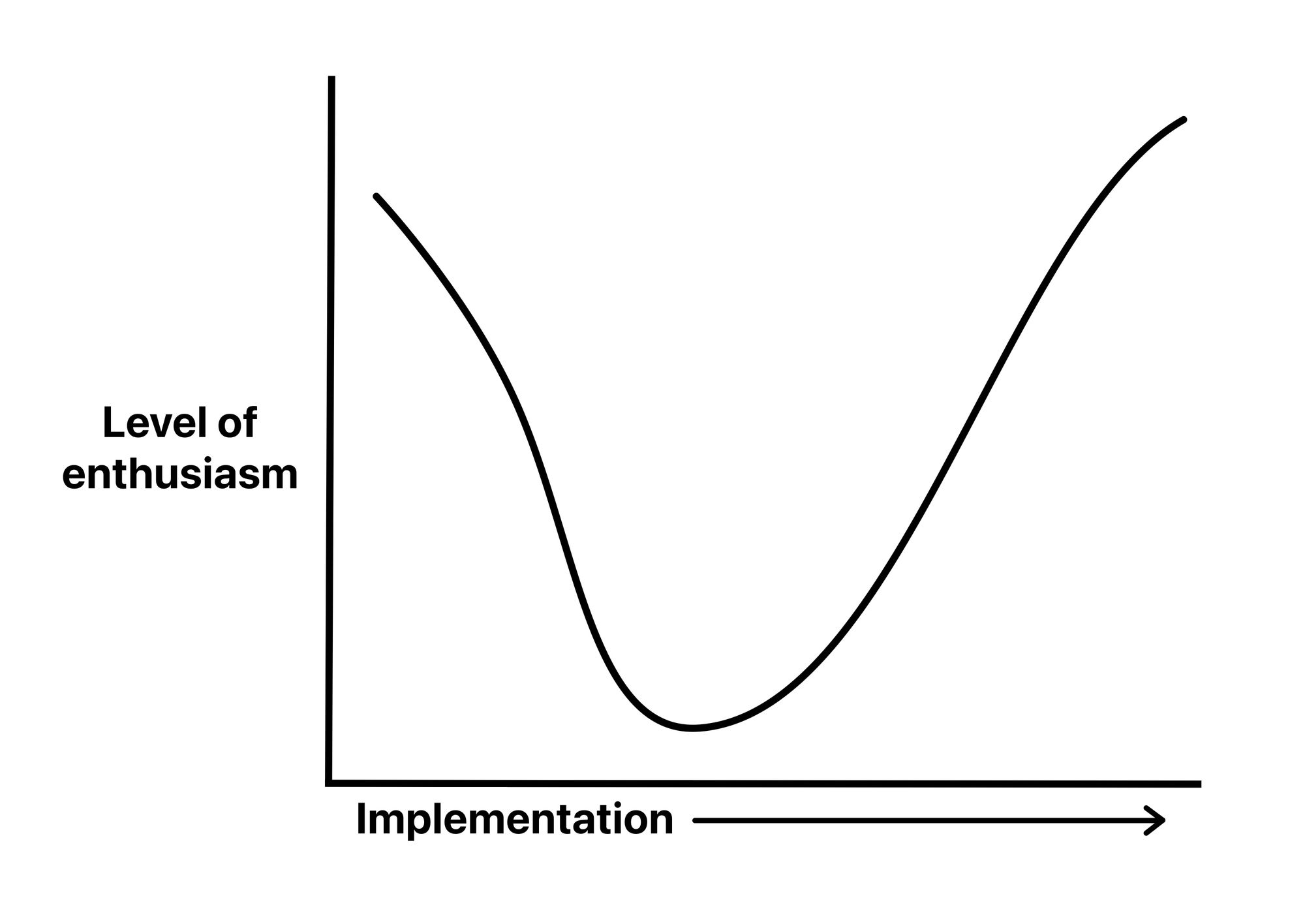If you think it's time to ease down and relax immediately after your deal is closed, think again because you may be wrong.
In strategic sales, it's incredibly common for salespeople to decrease their activity and involvement with their customers when signatures have been exchanged, whereas experienced sales professionals know the real work between your organizations is only about to begin.
Let’s dive in!
The capricious implementation stage
Just as you’d think you’d be safe to reduce the intensity, there’s another critical stage right there to bite you.
Among the never ending hard work that’s needed across the full spectrum of complex sales, when you feel you've deserved some rest – and I understand you – don't get easy.
Not only does your competition not ever sleep, but your customer is only getting started with your solution, so the hard work is only about to begin.
Well, I'd say maybe you can indeed relax – but only if you’re very lucky.
Why?
What tends to ensue next is something along the lines of a psychological rollercoaster, and it's integral for the salesperson to remain sensitive and alert during this period. Even when modern companies have increasingly embraced customer success teams emphasizing a smooth handover to implementation or customer care functions, there are many reasons for you to stay on your toes.
You have to keep in mind that psychologically the implementation stage is surely one of the most anxious and fear-inducing periods for your customer. What if things go wrong, or if your buyer thinks they've made a bad choice? Here their purchasing decision collides with reality and is about to be tested.
The time spent implementing your solution can be treacherous, but if you execute it well, it'll also become your most surefire way to get in a good word and generate additional revenue both inside and outside your account.
As there have been promises made throughout the buying journey, now they must be delivered upon.
What can the seller do?
Let’s first try to comprehensively understand the customer’s point of view regarding the psychological rollercoaster of emotions and perceptions that ensues.
The psychological stages of the implementation phase
Continuing from Rackham’s great book Managing Major Sales published in 1991, the implementation stage from the perspective of your customer’s psychology can be roughly broken down into the following three parts illustrated below. Let’s discuss each of these stages.

1. The "new toy" stage
Initially, there’s excitement and curiosity. Customers eagerly explore your product, trying out low-effort tricks, seeking out quick wins and achieving some immediate small results. Sometimes, the more sophisticated users in your client's account may already be exploring the more unusual or “techy” aspects of your product before getting down to serious work.
If you think about it more generally, everyone tends to play around with things when they're new. This kind of play serves a good purpose by building-up confidence in your solution and especially because your buyer will start instantly justifying the correctness of their buying decision.
In terms of your sales strategy it’s valuable for you to try and enable such behavior to the extent possible by building-in aspects that will quickly show first results for little initial effort. These kinds of quick wins will help support your client’s overall adoption journey.
Finally, it’s worth highlighting that just as with any high-technology solution, the "new toy" stage can happen with any other mundane, traditional, or a “boring” solution too. It may be just your 24/7 hotline that will be tried out, or some of your training content will be found amusing!
2. The learning stage
This is often the hardest stage of the implementation journey and it's where your client’s confidence-levels can sink to crisis levels. Psychologically speaking, as it often happens, the benefits tend to come in proportion to the effort invested. After the initial “new toy” stage, the excuriating process of actually implementing your solution begins.
For your client this stage is a lot about learning – and learning is hard work.
As depicted in the illustration, the effort needed for this stage tends to be higher than the results your customers are getting, making this part of implementation process extremely vulnerable.
This is just as true for any other type of learning you may have done. If you learned to play a musical instrument, started going to the gym or began riding a bicycle, you may have gotten discouraged when you ran into first difficulties.
When your client is in the process of installing your new advanced production system, during the early stages of implementation, it may still be easier for them to do things manually.
So what are some of the effects the customer perceives when having to invest all this effort?
As a rule of thumb, and especially for your less sophisticated clients, your buyer tends to underestimate the effort required to implement your solution, or the difficulty of getting the product to prove its full business value.
Your more advanced customers will tend to have less trouble during this "learning stage", especially if they’ve already implemented comparable solutions before. They tend to have a more realistic implementation plan helping them navigate and eventually achieve the full potential of your solution. Their past experience helps them cope with the many kinds of problems that arise with your less sophisticated customers.
A tip worth noting here is that for you as the seller, it is important to remain careful with using your client as a reference during this turbulent stage. It’s likely that emotions may still be on a rollercoaster ride leading possibly to some unpredictable reactions. If your customer is having a low moment and you ask your other prospective customers to contact them about their experience at that moment... Well, it may be a bad idea.
3. The effectiveness stage
As your customer gains a better understanding of your solution, the effort that goes into learning it will decrease dramatically. Your product or service will begin to show its real value, and the customer starts realizing the tangible benefits leading to a renewed sense of appreciation and reliance on your solution.
Here you’ve managed to navigate through the treacherous psychological stages of the implementation process and have began reaching the winning side of the overall project.
According to Rackham, if your customer says something along the lines of: “I could never go back to the old way of doing things”, or “How did we ever manage without it” – your implementation can surely be considered a success!
The "motivation dip"
Helping understand the three previous implementation stages, Rackham also introduced the concept of the “motivation dip” illustrated below. It shows your customer’s level of enthusiasm and how it changes across the implementation process.

Let's describe what we're seeing here.
At first, right after concluding the agreement, your client’s motivation is high, but after the “new toy” stage is over, your customer’s high expectations and motivation tend to start melting away.
Enthusiasm continues to drop rapidly as your customer proceeds to the middle parts of the learning stage.
As I briefly mentioned earlier, this not only happens with purchasing decisions, but remains a commonplace aspect in our everyday psychology.
When you start a new sport, despite your initial excitement, the magic tends to wear off quickly, and most people will experience a dip in their motivation. Many if not most will get discouraged.
Working with your customers, this is exactly where the value of your attentiveness and sensitivity grows in importance.
Continuing the sports analogy, the hobbyist may want to resort to old habits as the motivation continues to dissipate.
This is a high-risk phase for implementing any sort of change, whether we’re talking about simple weight loss and dietary discipline, or implementing a billion dollar installation. Here it is absolutely critical to put in extra effort as your customers are working hard but may not yet see the results they expect.
If the seller was painting a rosy picture leading to the customer expecting an easy time, they’ll come unprepared for the collapse in motivation when faced with real-world challenges that are bound to arise.
What is positive, however, is that the motivation dip doesn’t last. If you and your client can bear through it all, the effort will start paying off and the results will come.
With your sports hobby, you may see your technique start improving, or your weight start noticeably going down. Maybe you're now finally able to play an increasingly difficult composition with your instrument along with the song you so much love.
When results become visible, the motivation increases again and it's exactly what happens in the "effectiveness stage". This is when your solution finally proves itself and starts paying off. In order to reach it, however, you’ll need to put in quite some effort to survive the motivation dip!
Strategies for handling the motivation dip
After studying hundreds of customer engagements, Rackham identified three main strategies the more successful salespeople tend to use to ensure their customers get through the motivation dip with less difficulty.
1. Start before signing the contract: During the installation, your anxious client may be particularly sensitive to any signs of things going wrong. Naturally, because of this anxiety, they can overreact when faced with smaller difficulties. If you’ve done good work earlier in the sales cycle, your buyer will be less prone to overreacting when any of the inevitable difficulties arise.
One area important for resolving implementation anxiety comes from the earlier evaluation of options stage in the buying process. If you’ve ensured your customer genuinely perceives the product you offer as matching their decision criteria better than your competition, you’ll be half-way there with removing the most dreadful aspects of your client’s worries.
Likewise, your handling of any possible consequence issues is important before signing the contract.
If any unresolved issues remain lingering under the surface, your buyer will readily expect things to go wrong. This way the customer will focus heavily on any faults and remain blind to any of the positive successes happening across your implementation process.
2. Involve your customer: As I’ve discussed in one of my previous posts regarding the many psychological aspects at play in the process of negotiating, it may be a good idea to involve your customer in the process of planning your implementation and facilitating the needed change.
Generally speaking, bringing about any sort of change is difficult, and it's double-difficult if you’re trying to impose it on someone else. Making a detailed installation plan, and going step-by-step with your client through this process will require their input which serves as a yet another avenue for introducing your product and maximizing the chances of your implementation's success.
No surefire guarantees exist against unexpected problems, but if you’ve involved your customer early, they're likely to be more forgiving when problems spring up.
In short, customer's stake and motivation in the project will help make it a success.
3. Put in effort early: People who’ve proven to be effective in implementing new ideas or paving the way for adopting new organizational processes know that concentrating your most significant effort in the early stages is critical.
Mediocre sales professionals don’t know about these three implementation stages or the motivation dip, so when they see an excited client during the “new toy” stage, they'll think it will remain this way throughout the entire implementation journey. They proceed to give their account less attention failing to pick up on any of the warning signs that can lead to problems within their account. In the learning stage, mediocre sales professionals are taken by surprise and tend to wait too long to take corrective action.
Not acting upon these problems promptly will tend to exaggerate them leading to further frustration and dissatisfaction. As Rackham says, “fire prevention is a better strategy than firefighting”, and the motivation dip is far easier to handle if you put in your effort early on.
Make sure there's less of a chance for fires to break out in the first place – and you are half-way there.
In a future post, I’ll discuss transitioning from the implementation stage into active account development. For updates on this and more, consider subscribing to my very occasional hand-made newsletter below. Talk to you soon!

